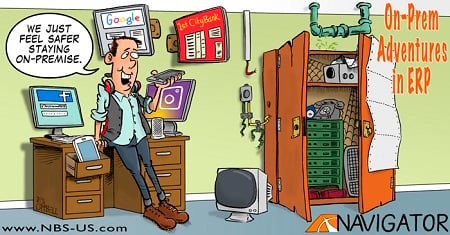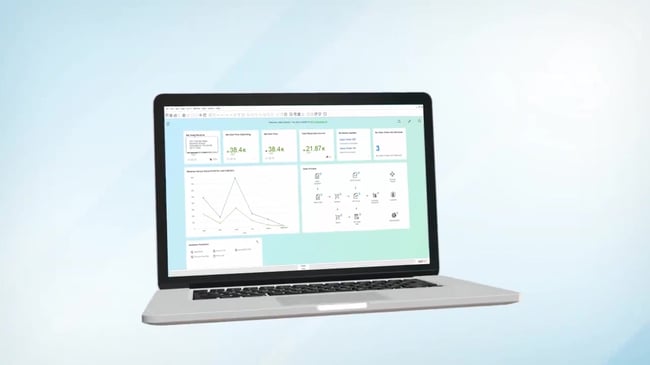- Solutions
- SAP Business Suite
- SAP Cloud ERP
- SAP Business ByDesign
- SAP Business One
- ERP Integrations & Extensions
- ByDesign vs. Business One
- Industries
- Services
- Resources
- Company
- WATCH DEMO
Search
Navigator was the leader in operating SAP Business One in the cloud, in fact, we became a cloud-only company 6 years ago. We have the experience to handle the transition to the cloud either “with you” or “for you”.
Optimize, scale, and extend your existing SAP Business One Cloud systems.
Whether you're migrating or modernizing, we provide the tools and expertise to help you thrive.
Let's Talk Shop! Connect with our experts.
If you're running an on-premise solution, no matter when you last upgraded, you are already behind with your service.
In the past, if you wanted to run an ERP solution like SAP Business One, you had to buy, implement, and host the hardware in your office yourself. The problem with the on-premise model is that it is time-consuming, resource-intensive, and can be an expensive solution.

Technology moves and improves quickly.
Legacy applications that will only run on older operating systems and/or web browsers and often lock organizations into older versions. Essentially, an organization with on-premise software is likely missing potential benefits from newer platform functionality.
A cloud solution, such as SAP Business One in the Cloud allows for scalability, easier upgrades, and the opportunity to connect to the latest technologies such as the Internet of Things (IoT), machine learning, Artificial Intelligence (AI), and so on.

On-premise technology requires significant and ongoing investment. On-prem users need to purchase, deploy, operate, and upgrade their own IT infrastructure to run the software. This is something that leading-edge cloud users in business are moving away from with cloud platforms.
The purpose of an IT department, regardless of a singular IT employee or team, should be freed of siloed systems and be enabled to act as an innovation center. Gone are the days of IT 'just holding it together.'

When running your organization on the cloud, you'll have access to all the latest features delivered wherever your business is getting done, in-office, at home, or on the road.
Migrating to SAP Business One Cloud helps:
An important factor in the decision to move from on-premise to cloud is cost. An on-premise system is hosted locally on your servers at your location. Your business is responsible for handling all the equipment needs and costs including, servers, physical infrastructure, and the skilled employees to run, back up, maintain (hardware and software), fix, and replace all that hardware.
In contrast, when running SAP Business One in the Cloud, all the infrastructure and system support needs are taken care of by Navigator Business Solutions and costs are consistent and predictable allowing you to focus your attention and employees on growing your business, not on computer support services.
Each approach has benefits for an organization depending on their needs and goals. On-premise systems can deliver a greater sense of ownership as the organization’s IT staff oversees security and maintenance. Cloud systems, however, are more accessible and are able to be accessed through a web browser allowing your business to be more agile and adaptive to changing business models and work environments. One thing COVID-19 has taught many business leaders is that having the systems in place that allow employees to work from anywhere (in-office, at home, or on the road) is critical to sustaining company growth.
When taking infrastructure into account while making a decision, organizations should take time to assess:
Consider the following examples:
When you are facing scenarios similar to these, the commercial benefits of going to the cloud far outweigh the cost of re-investing in new server infrastructure and employee time and cost.
With Navigator Business Solutions, SAP Business One cloud offering you get:
When you partner with Navigator Business Solutions to move from an on-premise to cloud instance of SAP Business One, the process is simple. We can take care of all aspects—including hosting/infrastructure and support. We will even let you test drive running your business in the cloud before you make the move. And as always you have the support and expertise of Navigator to keep your business systems running smoothly and up to date.
The key benefit of cloud-based SAP Business One is that it makes it easier for companies with multiple locations to centralize their business processes and improve efficiency across their services. This means that all employees can access real-time information from a single source rather than having to log in to multiple systems to get what they need.
You’ve likely heard the old saying “If it ain’t broke, don’t fix it”. Maybe that's true about some things, but following this advice when it comes to solutions and IT infrastructure can be a dangerous, and costly, mistake.
Upgrading to a Cloud Infrastructure and platform will help support:
Only use the resources your business needs, and easily scale as you grow. Whether scaling for seasonal demand or because of long-term business growth, SAP Business One Cloud makes it easy to add or remove users and adjust your computing needs as you go.
Reduce the long-term IT costs with SAP Business One Cloud by reducing implementation time and eliminating hardware and software maintenance. You also transform a large capital expense into a small ongoing operating expense.
Expand access to your data and business processes by making it accessible from any computer or mobile device with an internet connection. With SAP Business One Cloud, distributed teams, field service, traveling employees, and remote offices all can access the data they need when they need it.
When you choose SAP Business One Cloud, you automatically upgrade the data security of your business by taking advantage of the world-class data protection built into the AWS cloud. AWS uses state-of-the-art data security and loss prevention technology trusted by governments and businesses worldwide, including agencies that require security strong enough for top-secret clearance. AWS infrastructure also is 20 times more reliable than typical commodity disk drives, ensuring that all your business data stays safe from hardware and software malfunctions.
Businesses in the life sciences, consumer products, distributions, contract manufacturing, & development industries need efficient operations and speed to market. Enterprise resource planning (ERP) systems ensure that a business can stay lean and competitive while also enabling flexibility and scalability to support growth and long-term goals.
Small or large businesses tend to have similar needs when it comes to ERP: streamlined workflows through automated processes, visibility into operations, and stronger data analytics, to name a few. But the choice between an on-premise ERP solution and one based in the cloud is not the same for all businesses.

As some of the limitations and barriers to on-premise solutions have become more apparent, more businesses are turning to cloud solutions instead. In fact, the cloud-based ERP market is projected to reach $32 billion by 2023. The reasons are many.
A cloud-based ERP platform doesn’t require any upfront capital expenditure, which could run in the millions for an on-premise solution.
Cloud-based solutions are offered via an affordable subscription fee, which allows a smaller business to build an ongoing operational expense into its budget rather than requiring a huge initial capital expense. A limited budget doesn’t mean a business will sacrifice any functionality when it employs a cloud ERP solution; it frequently only means a faster setup, easier support, and less initial financial outlay.
In the past, ERP was viewed as an undertaking reserved for large companies because rolling it out was such a large project. Cloud ERP has been a game-changer for this calculus because implementation time is minimal, and the cloud vendor, rather than the business itself, handles all the hardware and software management.
This makes for easier configuration and shorter training times. A rollout that once typically took more than a year now can be completed in as little as a few weeks. Providers have developed solutions with specific industry needs to be baked in, too such as pre-validation for life sciences firms.
Companies have enough to juggle without adding the complexities of building a complicated IT infrastructure and managing the skilled staff needed to maintain it.
Cloud-based ERP requires less maintenance and fewer IT services; the solution provider handles all the back-end needs of the system. Because the IT footprint is simplified, in-house IT staff can focus more on strategic projects and less on routine system maintenance.
Cloud providers roll out automatic software updates seamlessly with minimal disruption or downtime.
Software stays better secure in this environment, and it reduces IT headaches when things go wrong. Furthermore, these updates are included in the price of the subscription, so there’s no need to budget for additional upgrade costs—something that can sometimes be substantial with on-premise ERP solutions.
Cloud-based ERP systems are comprehensive yet flexible. You can get out-of-the-box business processes for all your departments and operations, and they can be easily adapted to your organization’s specific needs at the same time.
Just as important, IT resources can be scaled up and down as needed with a cloud solution. Today’s cloud-based ERP comes with built-in integration tools and an architecture that can be integrated with third-party systems, and there’s no worry about running out of storage or maxing out hardware. The ERP system can scale to meet your business needs today while providing growth capacity down the line.
When ERP is in the cloud, you can ensure mobility and connectivity much more easily than you can with an on-premise system.
Cloud-based solutions can be accessed by users wherever they happen to be, offering opportunities for greater productivity and efficiency. Furthermore, smaller businesses can integrate with eCommerce channels and connect to online supplier networks just as easily as larger firms can, which aids competitiveness. For the same thing to happen with on-premise ERP, there are a lot more fiddly integrations and third-party connectivity software that may or may not get updated as cloud services and other systems evolve.
Should you stick with on-premise or move to the cloud?
Get an ERP second opinion when moving from on-premise to cloud ERP.
Register for a 35-minute SAP Business One demo - hosted every Friday at 9AM MT | 11AM ET
Then, you might be interested in all the key benefits of the cloud.
Understand the role of implementation partners with cloud-based ERP.